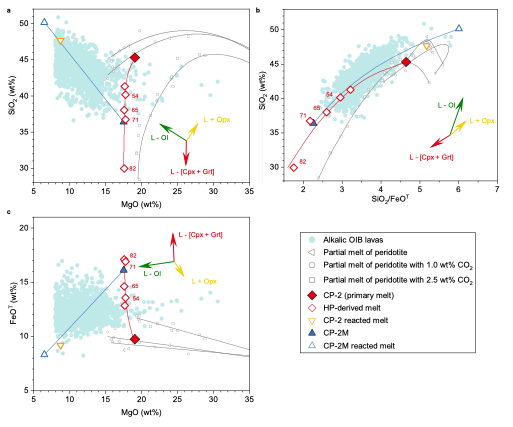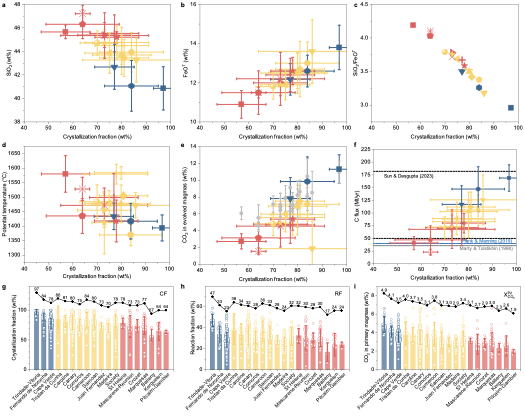Ocean Island Basalts (OIBs) are basaltic rocks formed by eruptions of hotspot volcanoes that are located inside oceanic plates. These volcanoes are closely related to upwelling plume materials originating from the convecting mantle. Determining the chemical composition and formation mechanism of OIBs is therefore of great importance to understanding the physical and chemical properties of the deep mantle, mantle dynamics, and the deep carbon cycle, making it a hot research topic in mantle geochemistry.
Compared with Mid-Ocean Ridge Basalts (MORBs), OIBs are predominantly alkalic basalts with low SiO2 content and high FeOT content (i.e., a low SiO2/FeOT ratio). Many models have been proposed to explain the formation of alkalic OIBs. However, most existing models focus on the effects of source mantle composition and the associated partial melting process, and have yet to simultaneously explain the low SiO2 content and low SiO2/FeOT ratio of alkalic OIBs (Figure 1).

A research team led by Associate Professor Zhicheng Jing from the Department of Earth and Space Sciences at the Southern University of Science and Technology (SUSTech), in collaboration with researchers from China University of Geosciences (Wuhan) (CUG (Wuhan)), has made significant progress in understanding the generation of ocean island basalts.
Their research has been published in the top-tier scientific journal Nature Communications under the title “Deep evolution of carbonated magmas controls ocean island basalt chemistry”.

Figure 1. Global intraplate OIB volcanism and compositions of alkalic OIB lavas
The research team focused on the effects of deep evolution processes of carbonated primary magmas in the mantle on OIB compositions. Employing a multi-anvil press and a piston-cylinder device, they conducted high-pressure and temperature experiments at 3 GPa and 1 GPa, respectively. These experiments simulated the crystallization of the partial melt of carbonated peridotite at the base of the lithosphere and the subsequent melt-lithosphere reaction during magma ascent.
The results showed that the combined effects of high-degree crystallization (> 50%) of carbonated primary melts—primarily producing large amounts of clinopyroxene and garnet—combined with the dilution effect of carbonate dissolution, would considerably decrease SiO2 content and increase FeOT content, thereby lowering the SiO2/FeOT ratio (Figure 2 and Figure 3). As these differentiated alkalic magmas ascend, they subsequently react with orthopyroxene in the shallow lithospheric mantle, assimilating orthopyroxene and crystallizing olivine and clinopyroxene. This reaction moderates the magma composition toward higher SiO2 and lower FeOT contents (Figure 2), eventually forming alkalic OIBs with varying compositions.

Figure 2. The composition evolution of carbonated alkalic OIB magmas
The researchers further established a quantitative model based on the evolution trends of four major components—MgO, SiO2, Al2O3, and FeOT—during deep crystallization and reaction processes (Figure 3). Using this model, they calculated the degrees of high-pressure crystallization, melt-lithosphere reaction, and the CO2 content in primary magmas for the generation of OIBs found on various ocean islands worldwide (Figure 4).
The study supports the positive correlation between the mantle potential temperature of different ocean island regions and the SiO2 content of their corresponding alkalic OIBs (Figures 1 and 4). This relationship suggests that lower mantle potential temperatures may lead to slower magma ascent, allowing more extensive high-pressure crystallization and melt-lithosphere reaction and in turn lower SiO2 in the erupted basaltic lavas.
Based on the model developed in this study, the estimated carbon outflux from Earth’s interior via ocean island volcanism is approximately 20–170 Mt/year (Figure 4f). This implies either a high net CO2 outflux from the Earth’s interior or that a significant portion of carbon released by magmas is stored in the lithosphere.

Figure 3. Effects of high-pressure crystallization on magma compositions

Figure 4. Correlations of alkalic OIB chemistry with a degree of high-pressure crystallization, melt-lithosphere reaction, and CO2 content in primary magmas
Research Fellow Junlong Yang from the Department of Earth and Space Sciences at SUSTech is the first author of this paper. Associate Professor Zhicheng Jing and Associate Professor Chao Wang at CUG (Wuhan) are the corresponding authors. Other co-authors include Professor Zhenmin Jin from CUG (Wuhan).
Paper link: https://doi.org/10.1038/s41467-025-60619-2
To read all stories about SUSTech science, subscribe to the monthly SUSTech Newsletter.
Proofread ByAdrian Cremin, Yilin ZHOU
Photo ByDepartment of Earth and Space Sciences